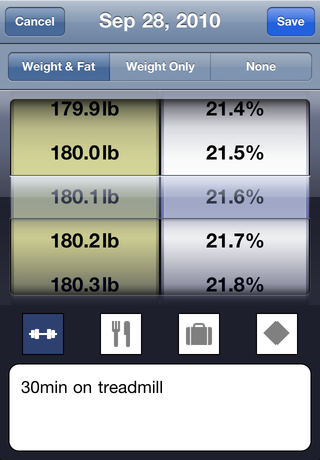
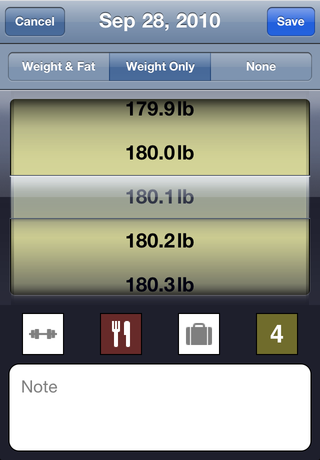
Every day, if you haven't weighed in yet, FatWatch will immediately take you to the weigh-in screen.
Step on your scale and then enter your weight by scrolling the picker wheel. If your scale also measures body fat ratio, you can enter that, too.
Since FatWatch remembers your weight, you won't have to scroll very far to match what you see on your scale.
It's fine to miss a day, or record body fat ratio on some days but not others. It's FatWatch's job to do the best analysis it can with whatever information you provide.
Besides your weight, there are four marks and a note field you can use to annotate the day.
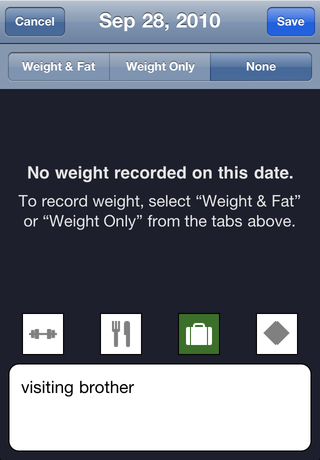
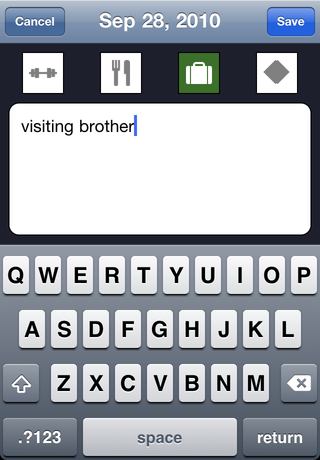
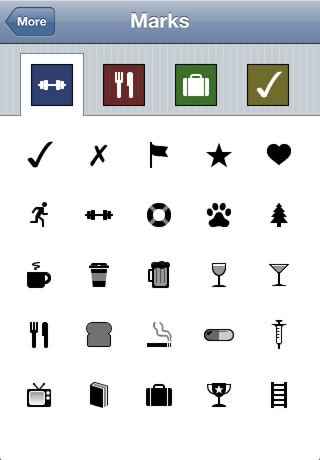
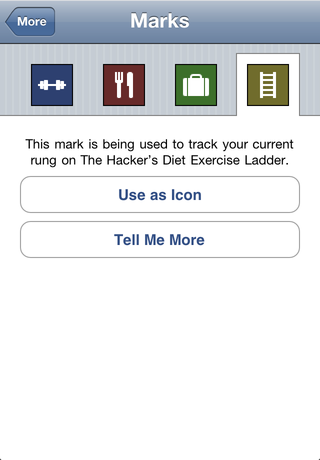
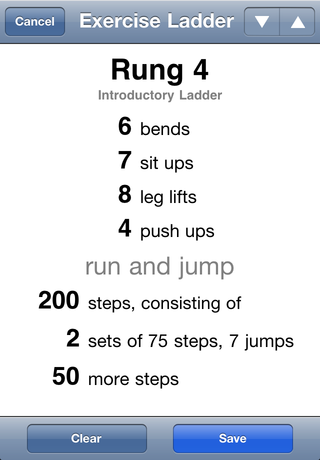
If you miss a day, you can tap None to omit weight for that day but still record a mark or a note, perhaps to explain why you couldn't weigh-in.
The four marks are colored blue, red, green, and gold. Each also contains an icon, which you can customize (via the More tab).
The marks can be used to indicate whatever you wish: went to the gym, drank beer, was away from home. If you are following the exercise program described in The Hacker's Diet, the gold mark can be used to track your current ladder rung.
When you're done editing the day, tap Save or Cancel to continue to the Log.
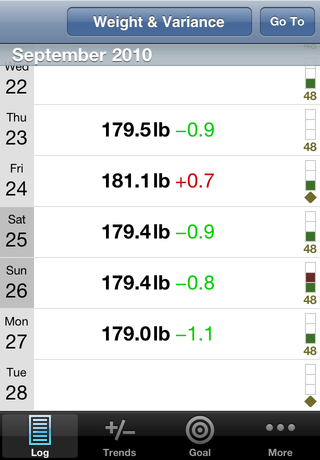
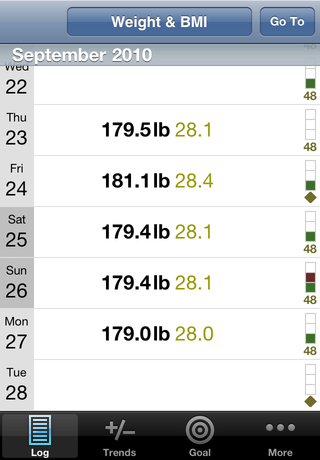
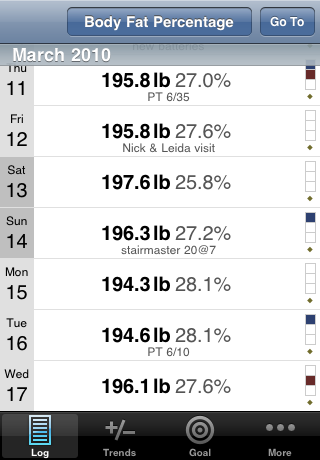
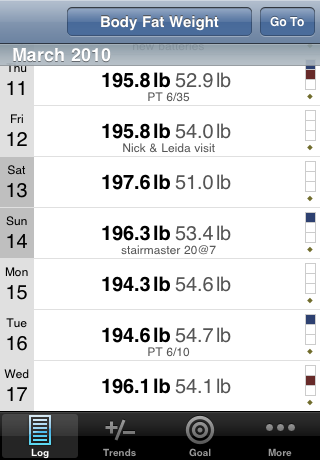
The Log allows you to browse your weight history numerically. At a glance you can see the progress you've made in the past week, or any other week in the past.
Tap the toolbar to cycle between different display options: Variance, BMI, Body Fat Percentage, and Body Fat Weight.
Variance is the difference between your scale reading and the moving average that FatWatch is tracking for you. (Note that this is not the same as change from your previous day's weight. See "How to interpret Variance" to learn more.)
BMI is your body mass index, which FatWatch will compute if you provide your height (via the More tab). The number is color coded based on guidelines set by the World Health Organization.
Body Fat Percentage is the percentage figure entered from your scale. Body Fat Weight is the amount of fat in your body, measured in pounds or kilograms.
Tap any row to go to the weigh-in screen for that date.
Tap Go To to quickly jump to a faraway date without having to scroll all the way there.
The tabs below will take you to the Trends, Goal, and More screens.
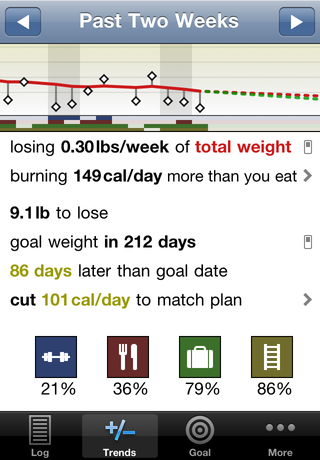
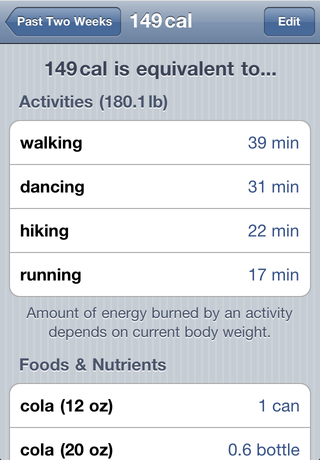
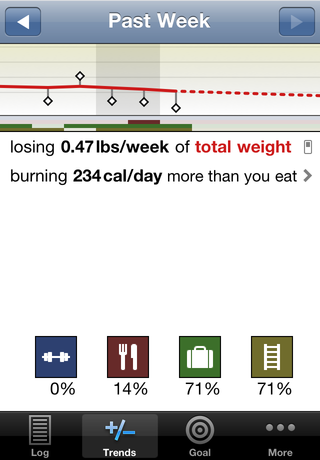
The Trends tab displays an analysis of your weight over a specified time span.
The arrow buttons in the toolbar allow you to switch between the Past Week, Past Two Weeks, Past Month, Past Quarter, Past Six Months, or Past Year.
The mini-chart displays a graphical representation of your weight over that time period. The diamond shapes indicate your weight on that day, and the red or blue line represents a moving average. The line is red if it is computed from total weight, blue if it is computed using your body fat ratio.
You can toggle between total weight and fat by tapping the text immediately below the chart (there's a switch icon to the right of the text to remind you of this). Oh, and if you'd like to see more detail chart, you can rotate your device sideways to see a full-screen chart.
Below the mini-chart, FatWatch describes the way your weight is trending over that period: in terms of weight per week and energy per day. If you've been recording your body fat ratio, FatWatch will perform analysis by changes in fat alone, otherwise it will use your total weight.
If you have set a Goal, FatWatch will provide additional information indicating when you can expect to attain your goal, and how to adjust your diet or exercise plans to get there by your selected goal date.
If you tap any of the energy-per-day figures, FatWatch will display a table of equivalent activities and foods. FatWatch comes with several items, but you can add or delete activities and foods as you wish.
At the bottom, FatWatch indicates how much of the time period each of your days were marked blue, red, green, or gold.
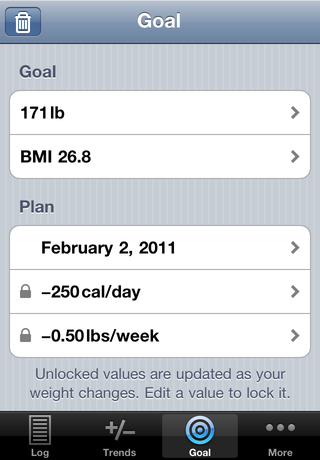
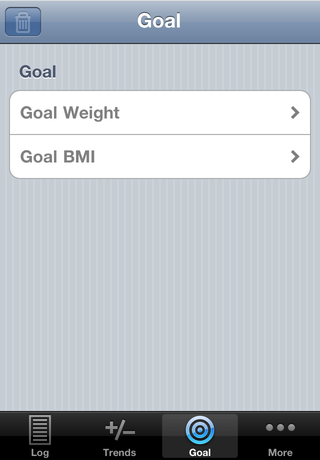
The Goal tab allows you to set a weight you'd like to be. If you've enabled BMI, you can set your goal weight by selecting a BMI number.
The Plan section contains a Date, a Weight Change, and an Energy Change. You can pick a Date, and the Change rows will be updated to reflect how hard you'd have to work to get there. Or you can set the Change rows and see what Date you will reach your goal.
The Date is "sticky", meaning that, over time, it will remain fixed and the Weight Change and Energy Change will be updated to reflect what you need to do to get your goal weight.
Tap the trash button on the top left to clear the goal.
When you set a goal, it will influence the display of the Trends and Chart.
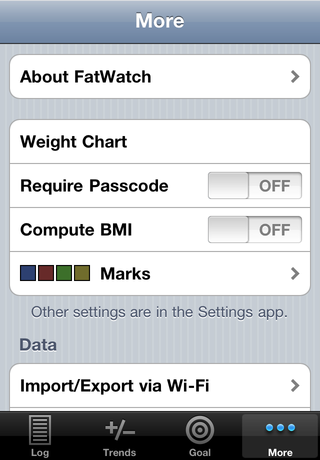
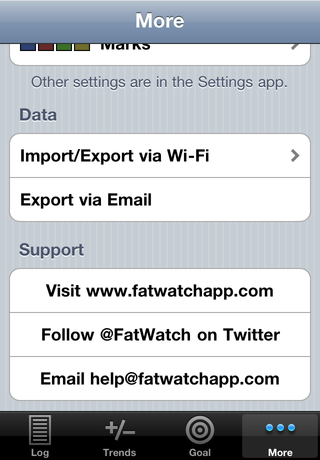
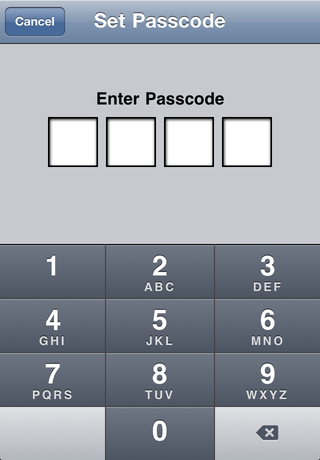
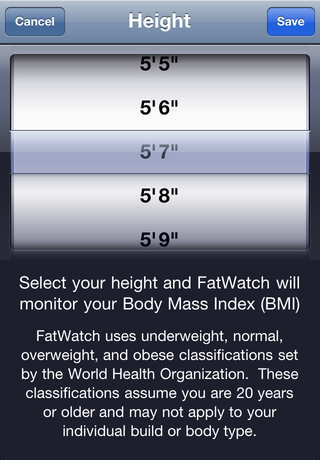
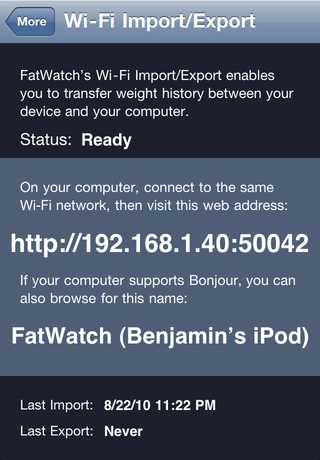
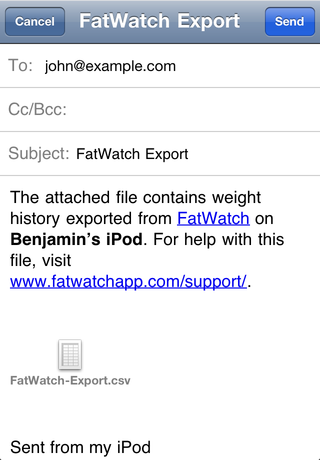
The More tab contains several extra features.
You can instruct FatWatch to require a passcode on launch, to keep your weight history locked behind a four-digit passcode.
You can ask FatWatch to compute your BMI, affecting the display of the Log, Trends, and Chart. (If you think BMI is bogus, you can leave it off.)
The Data section will allow you to import or export your weight history as a CSV file. Wi-Fi Import/Export can transfer your weight history to any PC or Mac on the same Wi-Fi network as your device, using a web browser. Export via Email allows you to quickly export your weight history and email it anywhere you choose. Send it to yourself to make a quick backup.
Additional buttons provide one-tap access to the FatWatch support page and email address. I am eager to help you with any problems or answer any questions you may have.
There are other settings that can be changed via the Settings app.
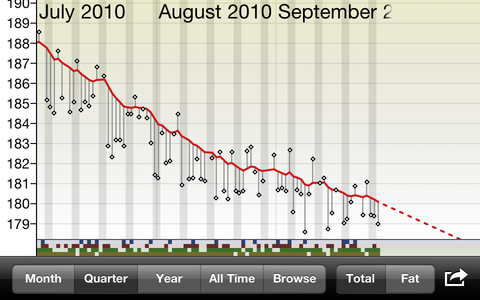
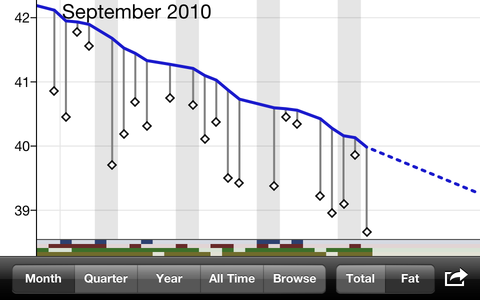
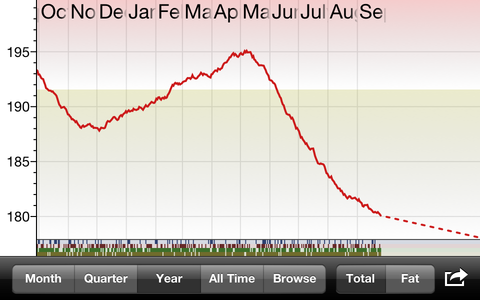
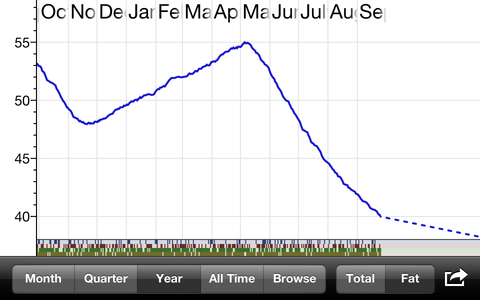
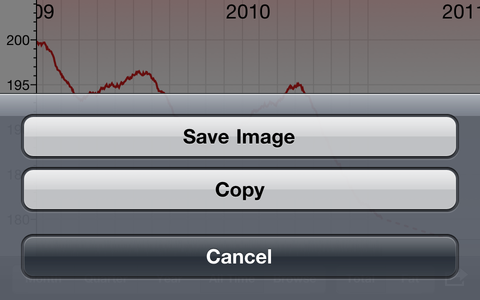
At any time, rotate FatWatch sideways to view your weight history in chart form.
Quickly tap between viewing the past month, past quarter, past year, entire history, or a scrollable month-to-month view.
You can also switch between a chart of your total weight or just your fat, if you've been entering your body fat ratio.
Your scale measurements from each day are shown in relation to the moving average line.
If you set a goal, it is represented by the green goal line, so you can compare your progress to it.
The bands at the bottom indicate which days were marked.
If you have enabled BMI, the chart background is color coded based on obese, overweight, normal, and underweight classifications set by the World Health Organization.
The action button allows you to copy a chart image to the clipboard or save it to your Photo Library.
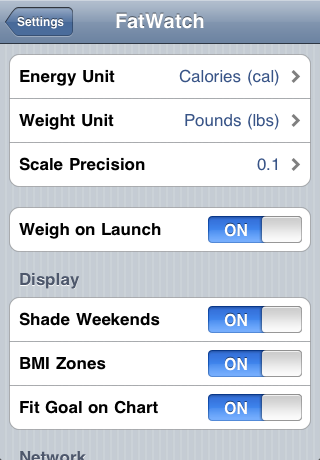
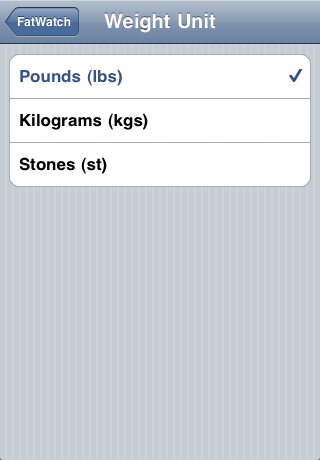
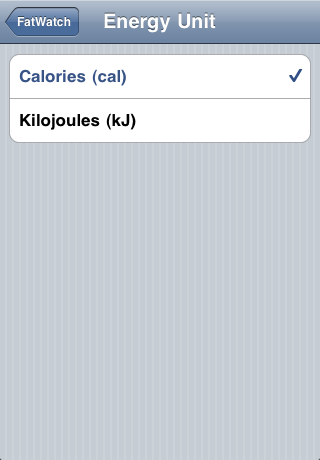
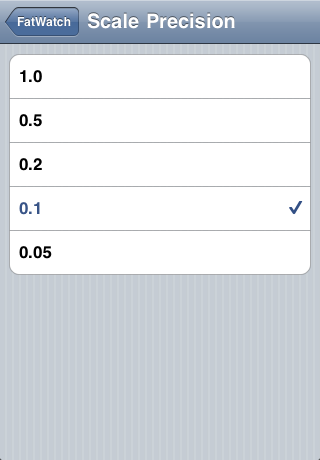
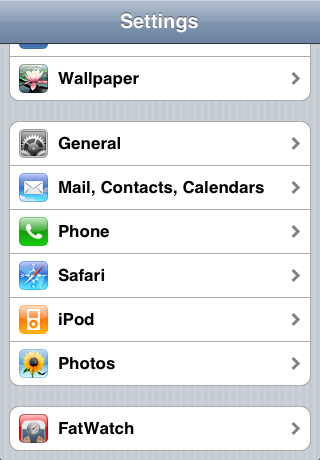
The first time you launch FatWatch, it will ask you for your preferred Weight Unit (pounds, kilograms, stones), Energy Unit (calories, kilograms), and Scale Precision (1.0, 0.5, 0.2, 0.1, 0.05).
Should you change your mind (or buy a new scale), you can change these settings in the system Settings app.
Disable Weigh on Launch if you don't want FatWatch to go directly to the weigh-in screen when you launch it.
You can disable Shade Weekends and BMI Zones if you want to keep the chart background clean.
Fit Goal on Chart will stretch the chart's vertical axis to include the goal. If you don't like that, you can disable it here.
Disable Bonjour if you do not want FatWatch to publish its address when you turn on Wi-Fi Import/Export, even thought it's much easier than typing in the address by hand.
And that concludes our tour! If you're not ready to get FatWatch now, please check out the FAQ.